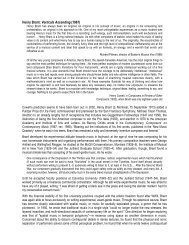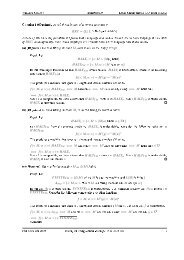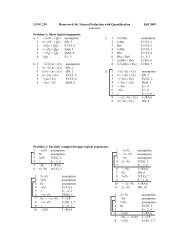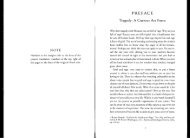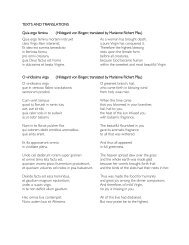handout: IPA symbols for American English
handout: IPA symbols for American English
handout: IPA symbols for American English
You also want an ePaper? Increase the reach of your titles
YUMPU automatically turns print PDFs into web optimized ePapers that Google loves.
front<br />
i 1<br />
central back<br />
high 1 u 1,3<br />
I<br />
U 3<br />
ej 2<br />
ow 2<br />
mid<br />
2/@ 5 diphthongs: aj aw Oj<br />
E<br />
O 4<br />
low<br />
æ<br />
A<br />
The vowels of <strong>American</strong> <strong>English</strong> have the following properties in most dialects:<br />
1 Many speakers realize the tense high vowels as slight diphthongs [ij uw].<br />
2 The tense mid vowels are usually realized as diphthongs [ej ow], but they can be monophthongs<br />
[e o], depending on the speaker’s dialect, surrounding sounds, rate of speech, etc.<br />
3 In many dialects (especially in the Western and Southern US), the high back round vowels are<br />
often pronounced with less lip rounding than other round vowels and/or a bit fronter than other back<br />
vowels. This is especially true <strong>for</strong> [U].<br />
4 In many dialects (especially in the Western US), the lax mid back vowel [O] is only found be<strong>for</strong>e<br />
[ô], as in [fOôs] <strong>for</strong>ce. Many other dialects (especially in the Northeastern US) contrast [O] and low<br />
back [A] in pairs like [kOt] caught versus [kAt] cot.<br />
5 The mid central vowels are distinguished by stress: [2] is always stressed, while [@] (a.k.a. schwa)<br />
is always unstressed. Schwa is also called a reduced vowel, because it is much shorter and weaker<br />
than other vowels, even unstressed vowels. Schwa varies quite a lot in pronunciation, sometimes<br />
higher [1] and sometimes also fronter [I], depending on the surrounding consonants.<br />
6 When the end of the syllable contains only voiced consonants, any stressed vowel is usually lengthened:<br />
[lu:z] lose versus [lus] loose, [hA:ôd] hard versus [haôt] welt.<br />
7 When a vowel is followed by a nasal stop in the same syllable, the vowel is (at least partially)<br />
nasalized (and if the conditions in Note 6 are met, it will also be lengthened): [bẼnt] bent, [bẼ:nd]<br />
bend, [lũ:m] loom, [lũ:n] loon, etc.




